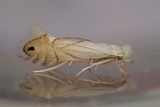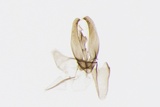Phyllonorycter heegeriella (Zeller, 1846) Species
Last modified: Dec. 14, 2024, 3:59 p.m.
Widely distributed in Belgium, but now local and very rare.
Details
- Classification
- Family: Gracillariidae > Subfamily: Lithocolletinae > Genus: Phyllonorycter > Species: Phyllonorycter heegeriella
- Vernacular names
- Gestreepte eikenvouwmot (NL), Pale oak midget (EN), Helle Schwarzpunkt-Eichenminiermotte (DE)
- First mention in Belgium
- Fologne E. 1859b. Supplément au catalogue des lépidoptères de Belgique. — Annales de la Société entomologique belge 3: 133–142. On page 142. view page
- Status
-
Native
Distribution
Caterpillar
Whitish with pale brown head.
Mine
A small (max. 10 mm), semi-circular tentiform mine on the underside of a leaf, most of the time situated near the leaf margin, which then folds downwards over the mine. The mine of the summer generation has one longitudinal fold, while the autumn generation has a whole series of fine lines very close to each other. The black frass is either scattered all over the mine or lies concentrated in one corner of the mine.
See also gracillariidae.net and bladmineerders.be.
Cocoon/pupa
The caterpillar of the summer generation constructs a tough, white cocoon that is attached to both the roof and the bottom of the mine and where the frass is used to align the sides of the cocoon. The caterpillar of the autumn generation constructs a much less tough, although larger cocoon in which no frass is used.
Bionomics
The species hibernation in the pupal stage, inside the cocoon, between fallen leaves among leaf litter on the ground.
The adults rest during the day on tree trunks or in the foliage. They become active during dusk and come to light.
Flight periods
Two generations a year in May–June and August.
Observed on
- Host plant (genera):
- Quercus
The caterpillar lives mainly on Quercus robur, but also on Q. petraea.


